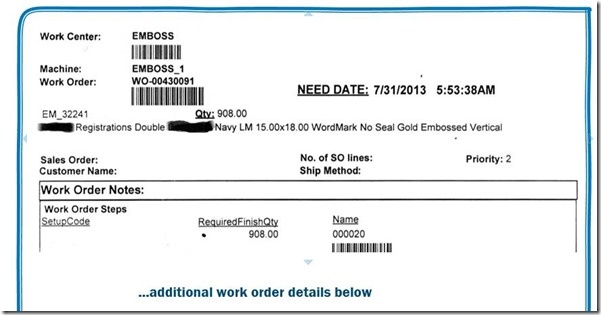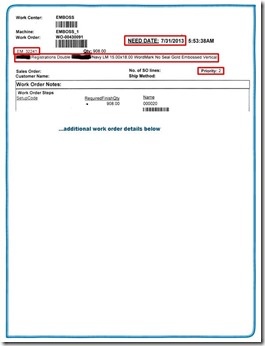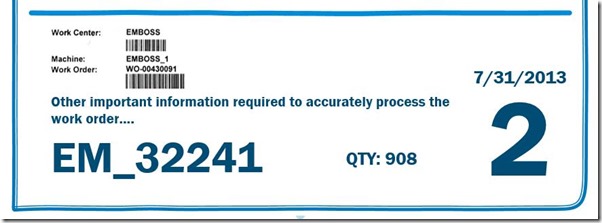I am a firm believer in what Dr. Eliyahu Goldratt calls “inherent simplicity.” That is the concept that the more complex a problem appears to be, the simpler the truly effective solution must be.
This became clear to me, recently, when I was working with one of our manufacturing clients. This client was reporting that they were spending considerable time tracking down the right materials for work orders on the shop floor. In fairness, the firm handles lots of small orders for mass-customized items, so they do face significant challenges. And, they also have costly automation at work in their enterprise trying to make life easier for themselves.
The problem is, all the costly automation is actually making daily shop floor execution more and more prone to chaos and consternation.
Let me see if I can describe their situation…
The illustration below is an example of a standard Work Order (WO) header, bearing typical WO header data:
- Work center (with bar code)
- Machine ID
- Work order number (with bar code)
- Produced Item ID
- Quantity required
- Some descriptive data
- Needed-by date
- Priority level
- Some other data

Below this header, all of the work order step details would appear.
Now, picture this, as the products moved through the plant, stacks of WIP (subassemblies) would be placed in various staging and storage areas. These work order documents would be left with the header portion sticking out from between the stacks so that workers needing to locate a particular subassembly for the next operation could find the parts they were seeking by reading the information on the exposed WO header.
The specific pieces of information that would provide the greatest clues to the workers as to appropriate actions are shown highlighted in red outlines in the full-page view shown here.
However, with the header sticking out from the piles of subassemblies, all these data had to be read UPSIDE DOWN by the workers looking for the pieces they needed to work on next.
Inherent simplicity in action
It was already clear that the technologies that this client had in place were only increasing the burden of effective manufacturing execution, so we were seeking an inherently simple solution to helping workers locate with speed and accuracy the components they needed to carry on with their productions.
Since the paper travelers had to stick out from between the stacks, we proposed that the Work Order form be reworked, moving the “header” information onto a “footer,” instead. This would allow the projecting portion of the work order to be read right side up, instead of upside down.
Next, we proposed that the important and human-readable information be made prominent and in large print to be readable from some distance. The result (as shown above) is a projecting “footer” that readily shows:
- Part Number of the subassembly: “EM_32241” in this example
- Priority: “2” in this example
- Needed-by Date: “7/31/2013” in this example
- Quantity: “908” in this example
A simple solution
Simply by making the document more human-readable and highlighting the key data that triggered action, actions on the shop floor were accelerated.
Next, rather than putting the WIP components in a relatively random order on the shelves based on when they were completed by the preceding operation, we suggested that the parts be grouped (like street addresses) by the component part ID. You know…
- The 10000 block
- The 20000 block
- The 30000 block
- And so forth….
These two simple, virtually no-cost changes helped our client toward accelerating their manufacturing execution and actually reduced their reliance on technologies.
That doesn’t mean they won’t need technologies in the future to accelerate some other aspect of their enterprise. But what it does mean is that they can reap the benefits of increasing Throughput today in order to liberate cash and increase profits to help pay for technologies where there is a desperate need for it.
We would be delighted to have your feedback on this article. Please feel free to leave your comments here or you may contact us directly.





